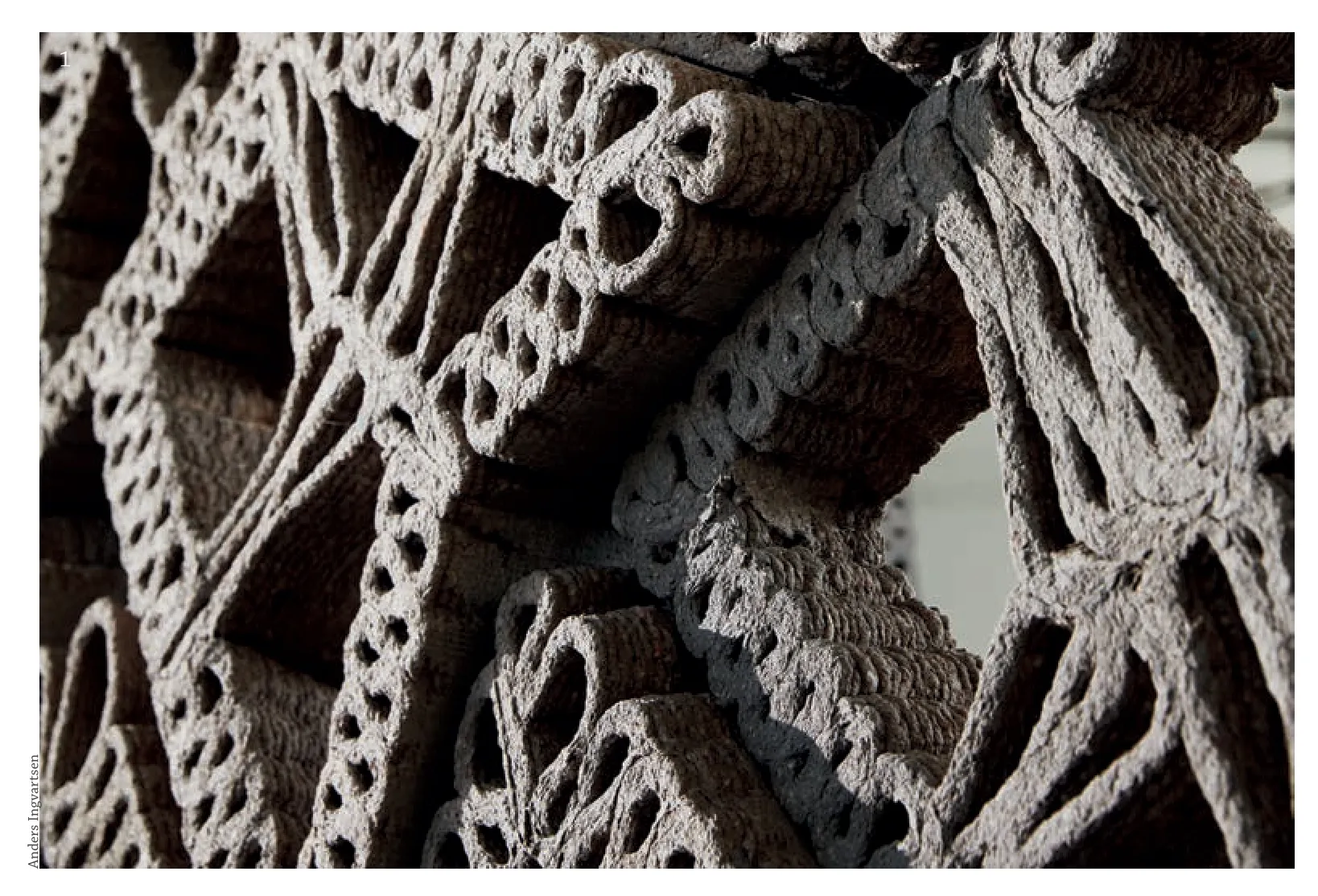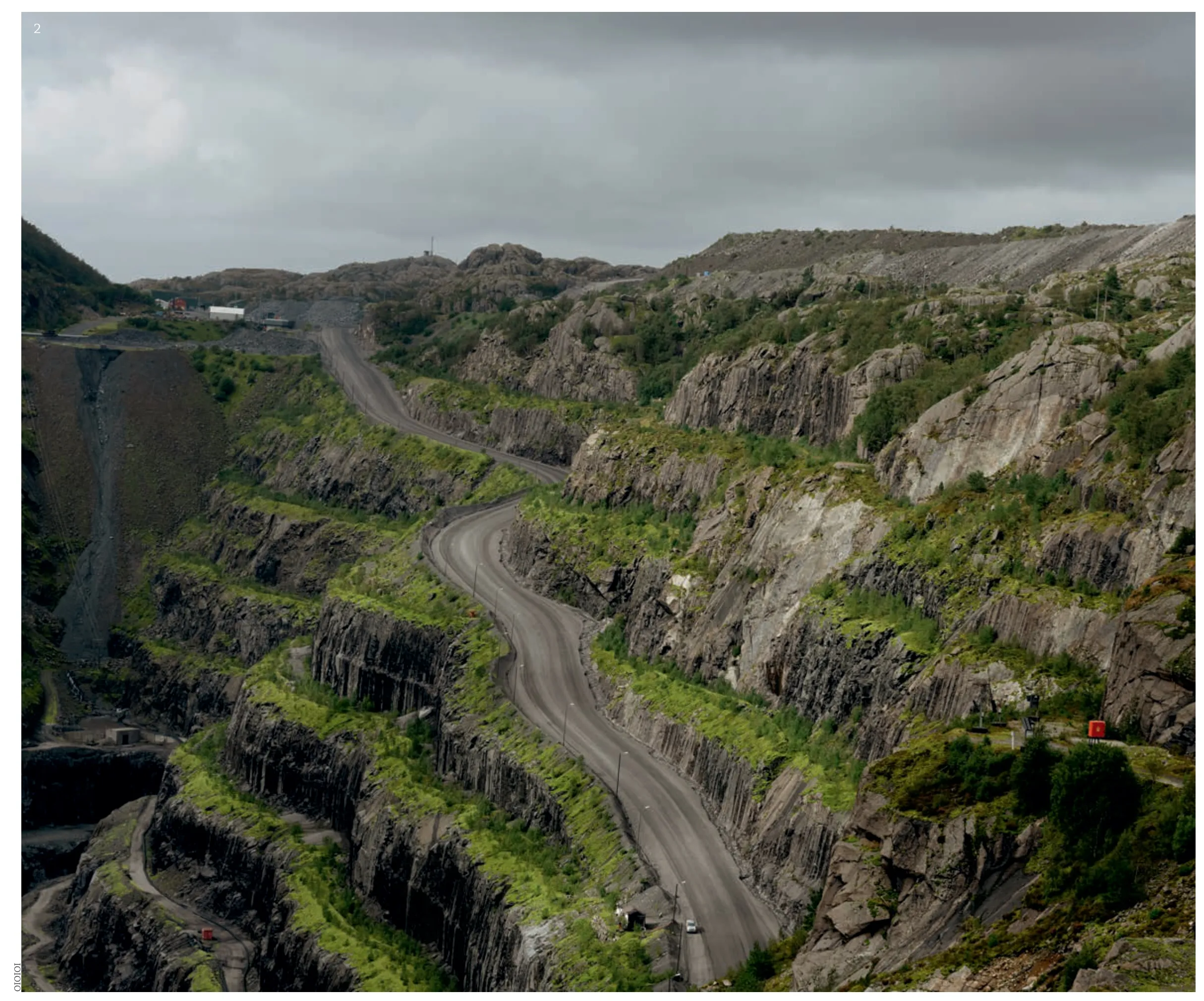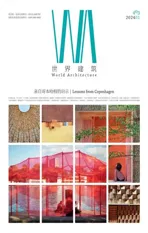为实现联合国17项可持续发展目标的建筑
——研究的作用
2024-01-27梅特拉姆斯加德汤姆森马丁塔姆克
梅特·拉姆斯加德·汤姆森,马丁·塔姆克
科学赛道是为国际建筑师协会2023 哥本哈根世界建筑师大会奠定知识基础的关键部分。通过6 个专题讨论小组,我们探讨了建筑及其实践如何成为实现联合国可持续发展目标的一部分。我们的目标是了解建筑研究和设计整合如何通过批判性思考及其应用来行动,在塑造我们的社会方面发挥独特的作用。本文将介绍科学赛道的目标、关注点和观点,我们讲述了如何通过6个小组的工作,使17 项联合国可持续发展目标在建筑实践和研究中变得易于理解和操作;我们如何围绕国际建筑师协会2023 哥本哈根议程,在研究和实践中建立起一个广泛的国际社区;我们如何质疑建筑研究的传播模式,以找到新的模式来捕捉和传播建筑知识文化的广度。
The Science Track has been key to creating the knowledge foundation for the UIA 2023 CPH World Congress.Across six panels we explored how architecture and its practices can be part of achieving the UN Sustainable Development Goals.Our aim has been to understand how architectural research and design integration bears unique agency in shaping our societies through critical thought and its applied action.In this article the ambitions,concerns and perspectives of the Science Track are introduced.We recount how we built the aim of making the 17 UN SDGs accessible and operational for architectural practice and research through the six panels,how we established a wide-ranging international community in research and practice around the UIA 2023 CPH agenda and how we wanted to question the model of architectural research dissemination to find new models that captures and communicates the breadth of knowledge cultures in architecture.
0 引言
2022 年秋天,作为国际建筑师协会2023 哥本哈根世界建筑师大会筹备工作的一部分,我们邀请小组主席、MASS 设计集团建筑师克里斯蒂安·贝尼马纳来到哥本哈根为我们的师生进行演讲。其中,他概述了卢旺达在过去50 年人口增长后土地使用的巨大变化。他通过地图说明,我们已经越过了一个临界点,现有的社会基础设施无法简单地拓展或对其进行优化以支撑目前的新形势。他强调,我们不能再建500 所大学或600 家医院,相反,我们需要进行系统性变革,重新思考什么是大学、什么是医院,需要思考我们的机构、基础设施和社区如何才能改变其满足需求、获得服务的方式,因此也需要思考建筑、实践、嵌入式知识和产品如何才能成为推动变革的方法。
国际建筑师协会2023 哥本哈根世界建筑师大会“可持续的未来——不让任何一个人掉队”科学赛道的6 卷论文集共收录了296 篇论文,这些论文调查、展示和论证了如何在建成环境中实现变革。通过探讨建筑如何帮助实现联合国可持续发展目标,论文集收集了全球社会的研究和实践成果。这些论文共同探讨了建成环境的未来,以及作为行动和知识的设计如何为建筑及其服务的社区发挥新的作用。
在两年半的时间里,我们与科学委员会的专家小组主席和特别顾问共同努力,实现了科学赛道的愿景。这个过程是一次教育,不仅有助于我们理解可持续发展目标、设计创造的变革力量或建成环境的广泛社会作用,还有助于我们以开放的心态看待建筑学的多种思考立场,以及建筑学在不同知识文化和观点之间的互动、交流和发展中所发挥的关键作用。论文中呈现的丰富观点和见解是科学委员会17 名成员、296 篇录用论文中的656 位作者、750 多篇投稿论文中的1486 位作者以及536 位同行评审者共同努力的结果,是他们使这一项目成为可能。
0 Introduction
In the autumn of 2022,as part of the preparations for the UIA World Congress of Architects 2023 Copenhagen we invited Panel Chair and MASS Design Group architect Christian Benimana to Copenhagen to speak to our collegiate and students.In his introduction he outlined the dramatic land use change in Rwanda following the country's population growth over the last 50 years.Pointing to the maps he argued that we have passed a tipping point and that our given societal infrastructures can not simply be extended or optimised to support this new situation.We can not build 500 universities or 600 hospitals,he said,instead we need systemic change to rethink what a university is,what a hospital can be.We need to question how our institutions,infrastructures and communities can change in the way they address those in need and what access can be,and therefore also how architecture,its practices,embedded knowledge and products can be methods of instigating change.
The six proceedings for the Science Track of the UIA World Congress of Architects 2023 Copenhagen Sustainable Futures -Leave No One Behind -contain a total of 296 papers investigating,showcasing and arguing for how change can be imagined across the built environment.By asking how architecture can help achieving the UN Sustainable Development Goals,the proceedings collect research-and practice-based results of a global community.Together they ask what the future of the built environment can be and how design as action and as knowledge can create new roles for architecture and the communities it serves.
During two and half years we have worked together with the Scientific Committee's Panel Chairs and Special Advisors to form a vision for the Science Track.The process has been an education.Not only in our understanding of the SDGs,the transformative power of design creation or the wider societal role of the built environment,but also in keeping our minds open to the many positions that architecture can be thought through and its critical role in engaging -interfacing,informing and developing -different knowledge cultures and perspectives.The richness of perspectives and insights presented in the papers are the result of an enormous collective undertaking by the 17 members of the Scientific Committee,the contributing 656 authors of the 296 accepted papers,the 1486 authors of the more than 750 paper submissions and the 536 peer reviewers that have all made this project possible.
1 Platform
The UIA World Congress 2023 Copenhagen starts with an ambition.Pitched in 2017,only one year after the launch of the UN Sustainable Development Goals,the central nerve is the articulation of the profound agency of architecture and how it plays an acute role in achieving the SDGs.In the congress,the Science Track is given a particular role.Initiated early in the planning process,the aim has been to place the Science Track at the heart of the congress in order to collect its underpinning knowledge foundation and shape its criticality through a broad outreach to a global community.Sustainability,like architecture,is a wicked problem.Its solutions are dependent on the way we ask,the methods we use and the contexts in which we work.To ask how architecture can be part of the dynamic fulfilment of the UN SDGs is to ask: who are the communities we design with and for,what is the knowledge we draw upon and how can its sharing change how we think about what our built environment can be.
One of the central drivers in our preparatory work for the Science Track has been the realisations of the blindness of the UN SDGs to the agency of architecture.The SDGs seek to steer behaviour both through impacting legislation as well as wider societal value sets.They establish priorities and galvanise efforts across communities by identifying targets and providing shared yard sticks in the form of indicators.In doing so they inscribe a world view of its defining actors;the governmental bodies,industries and communities that can be leveraged upon to instigate change.And in this world view architecture is strangely absent.At present,none of the UN SDGs declare targets that directly articulate architecture as a driver for change nor are there any indicators that evaluate its role.The built environment is only mentioned as a driver for resilient communities but without real value setting of the role of planning and design.This despite the extensive and complex impact architecture holds on human and more-than-human wellbeing;the way we live our lives,shape equity and use our resources.
1 平台
国际建筑师协会2023 哥本哈根世界建筑师大会以雄心壮志开始。2017 年,在联合国可持续发展目标发布仅一年之后,大会的核心是阐明建筑的深远影响,以及建筑如何在实现可持续发展目标方面发挥重要作用。在大会中,科学赛道被赋予了特殊的角色。早在规划过程中就已启动,目的是将科学赛道置于大会的核心位置,以收集其基础知识,并通过向全球社区的广泛宣传来塑造其关键性。可持续性与建筑学一样,是棘手的问题。其解决方案取决于我们提出问题的方式、使用的方法和工作的环境。要问建筑学如何才能成为联合国可持续发展目标动态实现的一部分,就要问:我们的社区与谁共创、为谁设计,我们吸收了什么知识,知识共享如何改变我们对建成环境的看法。
我们为科学赛道所做准备工作的核心驱动力之一,就是意识到联合国可持续发展目标对建筑领域的忽视。可持续发展目标旨在通过影响立法和更广泛的社会价值体系来引导行为,通过确定目标和以指标的形式提供共同的衡量标准,来确定优先事项和激励各社区的努力。在此过程中,它们为其定义的行动者(政府机构、行业和社区)设定了一个世界观,可以利用这些行动者来推动变革。而在这一世界观中,却匪夷所思地缺少了建筑。目前,联合国可持续发展目标中没有任何一项目标直接将建筑作为变革的驱动力,也没有任何指标对建筑的作用进行评估。建成环境只被作为建设韧性社区的一个驱动因素,但却没有对规划和设计的作用进行真正的价值设定。尽管建筑对人类和超越人类的福祉,对我们的生活方式、公平的形成和资源的使用,有着广泛而复杂的影响。
我们认识到这一点,并以此为总体目标,利用大会来提高共识。论证并展示建筑如何有能力改变我们理解和构建周围世界的方式,以及建筑作为一种直接参与立法、行业和建筑所在社区的情景实践,如何成为实现变革的直接方式。
2 愿景
科学赛道围绕6 个小组展开。这6 个专题讨论小组的愿景是就建筑如何参与实现可持续发展目标阐明6 个不同的观点,同时加强它们之间的相互联系。这些专题讨论会在一定程度上与现有领域相吻合,同时又提出了新的建议。通过汇集建筑学研究、实践与教育领域原本零散的知识,激发新的视角、新的联盟和具体的行动。科学委员会在阐述小组讨论时,提出了一些中肯而富有启发性的问题,这些问题对该领域提出了挑战,并将可持续发展目标定位为积极的目标。这些问题构成了6 卷论文集中每一卷的章节,询问建筑知识的创造如何创新建筑的思维、设计和制作。
(1)气候适应设计
全球社会都在紧急行动起来,适应地球不断变化的气候。作为人类最常见的栖息地,我们的建成环境应以可持续和可再生的方式与地球生态系统和气候相互作用。气候适应设计强调以人为本,通过多种形式的研究、知识和行动,提供高技术和低技术解决方案,使建筑、社区、景观、城市和地区具有再生能力、复原能力和适应气候变化影响的能力。
(2)资源反思设计
设计塑造了我们的世界,从居住的地方到每天使用的物品。随着我们越来越意识到地球资源的有限性,从开发性的设计思想转变为恢复性、再生性和循环性的设计思想就变得至关重要。反思资源的设计研究了建筑中的资源利用方法;可持续性如何挑战我们的材料实践基础,以及它们如何随之改变。
(3)韧性社区设计
具有抗灾能力的社区能够预测、适应并从逆境中恢复。气候变化、全球大流行病和许多国家的政治动荡揭示了社会、经济和环境的不平等,威胁着全世界的社区。这些断层对穷人、有色人种、种族或民族边缘化群体以及妇女的影响尤为严重。抗灾社区设计鼓励创新的解决方案,促进发展其适应和恢复所需的知识和技能。
(4)健康设计
建筑与健康密不可分。从医院和疗养场所的直接设计到基础设施和城市规划的战略设计,建筑影响着个人和社区的身心健康。为健康而设计提出了建筑学如何将健康重新视为一个设计问题。土地权如何影响健康生活,立法、规划和建筑如何影响不平等和用水,单体建筑以及医院、诊所和社区建筑等市政建设如何与当地环境和生态协调运作,为所有人创造安全健康的空间。
For us this realisation has led to the overarching aim of using the congress to build awareness.To argue for and demonstrate how architecture has the ability to afford change in the way we understand and construct the world around us and therefore how it as a situated practice engaging directly with both legislation,industry and the communities in which architecture takes place can become a direct way of effecting change.
2 Vision
The Science Track is formed around six panels.The vision of the six panels is to articulate six differentiated perspectives onto how architecture can be part of achieving the SDGs while reinforcing their interconnectedness.The panels are in part mapped to existing fields while at the same time suggesting new.By bringing together otherwise fragmented knowledge across the breadth of architecture's research and practices,the aim is to bring together knowledge across research,practice and education to provoke new perspectives,new alliances and concrete action.In articulating the panels,the Scientific Committee asks pertinent and provocative questions that challenge the field and position the SDGs as active goal posts.These questions form the chapters of each of the six proceedings volumes asking how architectural knowledge creation can innovate the thinking,design and making of architecture.
(1) Design for Climate Adaptation
With profound urgency,global communities are acting and adapting to the earth's changing climate.Our built environment,the most common habitat of humans,should interact with the earth's ecosystems and climates in a sustainable and regenerative way."Design for Climate Adaptation"emphasises people,multiple forms of research,knowledges and action for high and low-tech solutions that make buildings,neighbourhoods,landscapes,cities,and regions regenerative,resilient and adaptive to climate change impacts.
(2) Design for Rethinking Resources
Design shapes our world,from the places we live in to objects we use every day.As we grow more aware of the limits of our planet's resources shifting from an exploitative to a restorative,regenerative and circular design ideology becomes fundamental."Design for Rethinking Resources" examines approaches to resourcefulness in architecture;how sustainability challenges the foundations of our material practices and how they can change with it.

1 纤维素围护结构,来源:丹麦皇家建筑艺术学院 | Mette Ramsgaard Thomsen,Martin Tamke,Gabriella Rossi,Ruxandra Chiujdea,Konrad Sonne,Ariel Lim,Ellen Lau,Paul Nicholas Cellulose Enclosures,Credit: CITA,The Royal Danish Academy | Mette RamsgaardThomsen,Martin Tamke,Gabriella Rossi,Ruxandra Chiujdea,Konrad Sonne,Ariel Lim,Ellen Lau,Paul Nicholas

2 英格丽德·哈兰德与斯蒂安·罗西的论文《升级再造的地方主义——土工聚合物混凝土的美感》中的图片 Image in Upcycled Regionalism: The Aesthetics of Geopolymer Concrete by Ingrid Halland and Stian Rossi
(5)包容性设计
任何人都不应该因为自己的身份或缺陷而在不安全、不舒适或不方便的情况下体验空间。可持续性,就其最全面的定义而言,离不开集体行动。包容性设计旨在批判性地界定我们究竟排斥了哪些人以及排斥的原因,从而有条不紊地制定战略,减轻这种排斥。
(6)变革伙伴关系的设计
变革伙伴关系的设计旨在认识到国家、公共空间、公民社会和私人领域之间的不对称关系,从而为现有的权力结构找到新的平衡点。通过对普遍主义本体论的挑战,它探讨了建筑和建成环境如何通过地方治理,空间营造实践,想象多元政治、社会和生态可持续未来的情景,在创造关爱的土壤方面发挥重要作用。
3 关键立场
两年半的筹备工作是一次鼓舞人心的经历,通过这次经历,我们见证了建筑思维在行动中的力量——其批判性和创造性思想的交织,以及其面向未来的内在创造力。作为策划这项工作的一部分,我们确定了一系列关键立场,以此来理解建筑思维与联合国可持续发展目标之间的关联。
(3) Design for Resilient Communities
A resilient community anticipates,adapts to,and recovers from adversity.Climate change,the global pandemic,and political upheavals in many countries have revealed social,economic,and environmental inequalities that threaten communities worldwide.These fault lines disproportionately impact the poor,people of colour,the racially or ethnically marginalised and women."Design for Resilient Communities" encourages innovative solutions and facilitates the development of knowledge and skills necessary for adaptation and recovery.
(4) Design for Health
Architecture and health are inseparable.From the direct design of hospitals and places for healing to the strategic design of infrastructures and city planning,architecture affects physical and mental health of individuals and communities."Design for Health" asks how architecture can reconceive health as a design issue.How land rights impact healthy living,how legislation,planning and building impacts inequality and access to water and how single buildings and the civic construction of hospitals,health clinics and community buildings can operate in unison with local environments and ecologies to create a safe and healthy space for all.
(5) Design for Inclusivity
No individual deserves to experience space in a manner that is less safe,less comfortable or less accessible as a result of their identity or challenges.Sustainability,in its most holistic definition,cannot be achieved without a collective act."Design for Inclusivity" aims to critically define the constructs and categories of who exactly we are excluding,and why,in order to mindfully develop strategies to mitigate this exclusion.
(6) Design for Partnerships for Change
"Design for Partnerships" is about recognising the asymmetrical relationships between states,public spaces,civil societies and private domains to find new balances for the existing power structures.By challenging the ontology of universalism,it examines how architecture and the built environment can play an essential role in creating a ground for care through local governance,space making practices,imaginaries and scenarios of plural(istic) political,socially and ecologically sustainable futures.
3 Critical Positions
The two and half years of preparation has been an inspiring experience through which we have witnessed the power of architectural thinking in action -its interweaving of the critical and the creative ideation as well as its inherent inventiveness orientation towards the future.As part of the curation of this work we have defined a series of critical positions by which to understand the correlation between architectural thinking and the UN SDGs.
A first position has been to challenge the inherent anthropocentrism and perceived lack of hierarchy between the goals;the Tabula Rasa effect as Johan Rockström names it[1].The SDGs have been criticised for failing to recognise that planetary,people and prosperity concerns are interconnected[2].In forming the six panels of the Science Track we seek to position a rupture to the modernist axiom that the environment is situated outside of us.Instead,we understand the SDGs as a balancing between planetary and human needs which needs to be holistically addressed.
A second position is the critical appreciation that the SDGs retain an adherence to an underlying model of growth.The Science Track asks what the future practices of architecture can be,what the ethical roles of architectural design are and how architecture knowledge can create change in how architecture is produced both within and without of models of growth.It seeks to identify who the partners of architecture practice can be both through grassroot community action and through industry-based models.
A third position is the challenge of the embedded universalism within the SDGs.The SDGs maintain a universalism that is common to the UN system and underlies much of UN's work.However,this fundamentally modernist position of understanding sustainability as "a problem to be solved" and placing agency with legislation leaves questions of agency,voice and power unchallenged.
第一种立场是质疑固有的人类中心主义和目标之间缺乏层次的看法;约翰·罗克斯特伦称之为“白板效应”[1]。有人批评可持续发展目标未能认识到地球、人类和繁荣问题之间的相互关联[2]。在组建科学赛道的6 个小组时,我们试图打破现代主义的公理,即环境是在我们之外的。相反,我们将可持续发展目标理解为地球与人类需求之间的平衡,需要全面解决。
第二种立场是批判性的赞赏,认识到可持续发展目标仍然坚持一种基本的增长模式。科学赛道提出的问题包括:未来的建筑实践会是怎样的?建筑设计的伦理作用是什么?建筑知识如何在增长模式之内和之外改变建筑的生产方式?它试图通过基层社区行动和以行业为基础的模式,确定谁可以成为建筑实践的合作伙伴?
第三种立场是对可持续发展目标中内含的普遍性的挑战。可持续发展目标保持了联合国系统所共有的普适性,这也是联合国大部分工作的基础。然而,这种将可持续性理解为“一个有待解决的问题”并将机构置于立法层面的基本现代主义立场,使得机构、发言权和权力问题未受到质疑。科学赛道试图通过小组讨论及其相关的子问题将这一批评纳入其中,引发人们对建筑本身的人文主义传统的中立性的反思,并坚持质疑建筑是如何由人建造、为人服务的。
对普适性的挑战也导致了对知识传播科学实践的审视。论文征集活动有意鼓励不同知识和实践孤岛之间的交流和学习。这可以通过不同的出版形式来实现,其中包括科学知识生产以及基于设计的知识生产,口述历史、视觉文章等叙事形式,以及基于对话的交流和论证论文。这些形式的目的是扩大跨学科知识交流的可能性,并吸纳学术和专业话语中不常见的声音。
第四种立场也是最后一种立场是将可持续发展目标理解为不断变化的世界的一部分。可持续发展目标提出了一个长达14 年的项目。任何如此长的项目都需要建立审视自身基本价值观和核心概念基础的方法。气候变化的影响不断加剧和累积、新型冠状病毒大流行的后果、世界资源的持续紧张,以及乌克兰等地战争的爆发,都对全球社会产生了深刻而不平等的影响[3]。参与可持续发展目标就是将目标与对需求和手段的不断变化的理解联系起来。这意味着要致力于持续解决变革的背景和手段问题。在科学赛道中,我们通过对前沿研究、现实世界案例研究和近期重要论点的介绍,将重点放在具体和可操作的方面,从而促进对可持续发展目标的理解。这一重点将可持续发展目标与多种多样的建筑实践以及建筑所处的不同地点联系起来。本书的视角、方法和手段都很宽泛,力求体现系统性变革所需的解决方案空间的广度;特意包含了不同的声音和不同的风格,以展示创造这种变革的不同参与者、不同的知识流和不同的机构。
4 视角
大会科学赛道的成果是一部6 卷的会议文集,对建筑如何参与实现可持续发展目标进行了广泛而多样的诠释。在各个章节中,我们可以看到广泛的调查,探讨谁是社区、谁是参与者以及建筑生产的手段是什么。他们在设问:我们如何塑造建筑思维的方法及其相关技术?如何传播这些方法以及分享这些方法的结果是什么?
会议文集记录了当下的时代。作为研究分支,它们是更大的知识创造路线的一部分。我们举办世界建筑师大会的目的是促进新的讨论和交流,从而实现跨部门和跨地域的协同增效,但很显然,这一对话的全部潜力才刚开始显露出来。世界建筑师大会恰逢可持续发展目标过半之际。可持续发展目标于2016 年启动,预计在2030 年完成,我们需要从规划和推演过渡到行动。因此,科学赛道的工作具有紧迫性。我们的愿望是,这项工作不以各自的成果来限定,而是努力将其作为未来交流与合作的起点。我们希望,在这里创建的是一个由致力于后代福祉的行动者组成的社区。我们希望,这个项目的遗产将是我们能够坚持这一承诺,并使其利益相关者不断壮大,从而使这些主张成长为可付诸行动的变革。□(会议论文请见链接https://link.springer.com/conference/uia)
The Science Track seeks to incorporate this criticism through the panel calls and their associated sub-questions by provoking reflection on the perceived neutrality of architecture's own humanist traditions and insist on the query of how architecture is produced,by people and for people.
The challenge to universalism has also led to a review of the scientific practice of knowledge dissemination.The call for papers deliberately encourages exchanges and learnings across different knowledge and practice silos.This is effected through differentiated publication formats that include scientific knowledge production as well as design-based knowledge production,narrative formats such as oral history,visual essays,as well as dialogue-based exchanges and argumentative essays.The aim of these formats is to expand the possibility of transdisciplinary knowledge exchange and include voices that are not commonly part of academic and professional discourse.
The fourth and final position is to understand the SDGs as part of a changing world.The SDGs set out a 14 year long project.Any project of that length needs to build in methods of reviewing its own fundamental value sets and core conceptual foundation.The intensifying and accumulating effects of climate change,the aftermath of the COVID-19 pandemic,the continued stress on the world's resources and outbreaks of wars such as in the Ukraine have deep and unequal repercussions on global communities[3].To engage with the SDGs is to correlate the goals to a changeable understanding of both needs and means.It is to commit to a continual address of both the contexts and instruments of change-making.In the Science Track our focus on the concrete and the actionable through presentations of cutting-edge research,real world case studies and near future focussed arguments,argue for a situated understanding of the SDGs.This emphasis contextualises the SDGs within the multiple and diverse practices of architecture as well as the disparate places in which architecture takes place.The perspectives,methods and means are purposefully broad.They seek to represent the breadth of the solution space needed for the systemic change needed.They also purposefully include different voices and different styles to make present the different actors,different knowledge streams and different institutions that create this change.
4 Perspective
The result is a six-volume proceedings tracking a wide and multifarious interpretation on how architecture can be part of achieving the SDGs.Across their individual chapters we see a breadth of enquiries asking who the communities are,who the actors are and what the means of architectural production are.They ask how we can shape the methods of architectural thinking as well as their associated technologies,how they can be distributed and what is the consequence of their sharing.
The proceedings instantiate a moment in time.As research strands,they are part of larger trajectories of knowledge creation.Where our aim for the World Congress was to facilitate new discussions and exchange enabling synergy across silos and geographies,it is clear that the full potential of this conversation is only just beginning.The World Congress coincided with the halfway mark of the SDGs.Launched in 2016 and with a projected completion date of 2030,we need to transition from a place of planning and speculating to one of action.The work of the Science Track is therefore marked by a sense of urgency.The desire is to define the effort of this work not in terms of their individual results,but more as a launch pad for future exchange and collaboration.We hope that what is created here is a community of dedicated actors all with a shared stake in the wellbeing of future generations.Our hope is that the legacy of this project will be that we can retain this commitment and grow its stakeholders to mature these propositions into actionable change.□ (Please find full paper via the link https://link.springer.com/conference/uia)
